Nuts & Bolts #7: The Three Stages of Design
Every year, I write an article called "Nuts & Bolts" dedicated to the readers at home who are interested in designing their very own Magic sets. It is an inside look at our design process, leaning toward explaining some more practical applications. Even if you aren't making your own Magic cards, I hope this series will give you a better insight of how design does what it does. Let's start by quickly recapping the previous six "Nuts & Bolts" article.
Nuts & Bolts #1: Card Codes
The first article was about the card codes we use to make our files. While very detail oriented, it was information that was important to explain so we could build upon it.
Nuts & Bolts #2: Design Skeletons
The second article talks about one of the most valuable tools for building a design file, something known as a design skeleton.
Nuts & Bolts #3: Filling in the Design Skeleton
The third article talks about how to start filling in the design skeleton focusing on the commons.
Nuts & Bolts #4: Higher Rarities
The fourth article then focuses on filling in the rest of the rarities.
Nuts & Bolts #5: Initial Playtesting
The fifth article talked about how to best playtest your set.
Nuts & Bolts #6: Iteration
The sixth article talks about the concept of iteration. It is the process through which you improve your set over time.
Which catches us up to this article. Today, I'm going to pull back the focus a little and talk about the overall structure of Magic design. You see, the whole process is all about filling in the design skeleton, playtesting, and iterating, but there is a larger process happening along the way and I wanted to spend today's article explaining what that process is and how it can help you understand where you are in your design process.
All the World's a Stage
Several years ago, when Mark Gottlieb first became the design manager, he came to me and said that he was interested in breaking down the process of design. To help train our team as well as allow others outside of design to better understand what we were up to, he wanted to break down the design process into stages. Instead of design being a big black box that things just came out of, he wanted to better explain how we did what we did.
So he and I sat down and I walked him through how I felt design worked, step by step. As we talked, it became clear that there were three distinctly different yet equal-sized stages—what we have since named the vision stage, the integration stage, and the refinement stage. As large set design is a year long, each of these three stages lasts for fourth months. My goal today is to explain how each of these three stages work, what part of the design happens in each and how the stage impacts the way we do things like change the card file, playtest, and iterate.
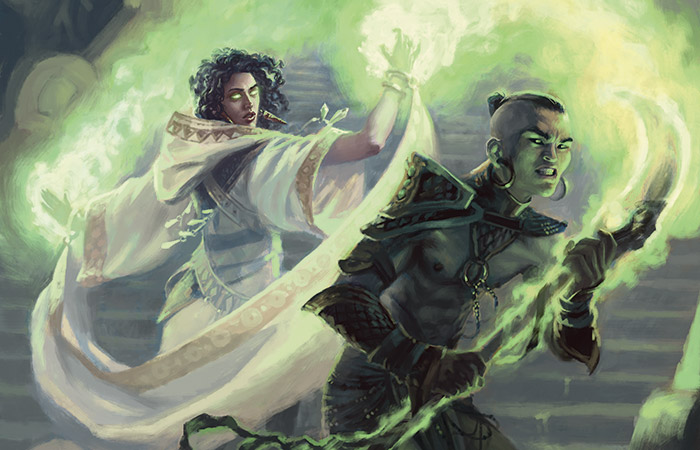
Abzan Advantage | Art by Winona Nelson
The Vision Stage
This first stage is about creating a vision for the set. What exactly is the set about? What are its themes? What are its mechanics? What emotional impact is the set supposed to create? What story does the set have to reinforce? This first stage is about defining what the set is up to, crafting its structure, and building its foundation.
Now, before design begins, we have something we call exploratory design. (Once upon a time we called it advanced planning and you can read about it here.) The role of exploratory design is not about finding answers but rather asking questions. It is important for us to walk into a design with a good understanding of all the constraints being put before us. Exploratory design allows us the luxury of scoping out problems we're going to have to solve before we have to actually solve those problems. The exploratory design team also comes up with a lot of ideas of mechanical directions we could explore. Thus, when we start design we're not starting from ground zero like most of you most likely will be.
The point of a vision is six-fold:
#1—It Creates a Bull's-Eye
A design team has many resources but if those resources are not all aimed in the same direction, a lot of work can be wasted. The first role of a vision is to get the team all moving in the same direction. This applies not just to the design team but to all of the company. From creative to development to digital to organized play to marketing, you want everyone who works on the set to all be working toward the same goal.
#2—It Spurs Ideas
"Restrictions breed creativity" is my mantra. If you want to get the creative juices flowing, it helps to nudge the brain in a direction outside its normal comfort zone. A big part of creating a vision is to map out a new mindspace to explore. One of my goals every design is for the design team to approach the design in some way different from how we've approached designs in the past.
#3—It Defines What's Important
If everything is of equal importance, nothing is important. A vision helps create priorities for your team. It tells the team which direction to go when they come to forks in the path.
#4—It Creates a Foundation
The hardest part of building a tower of cards is placing the first two cards because they have nothing to lean on. Setting vision is figuratively setting the first two cards for your team so they can build the tower.
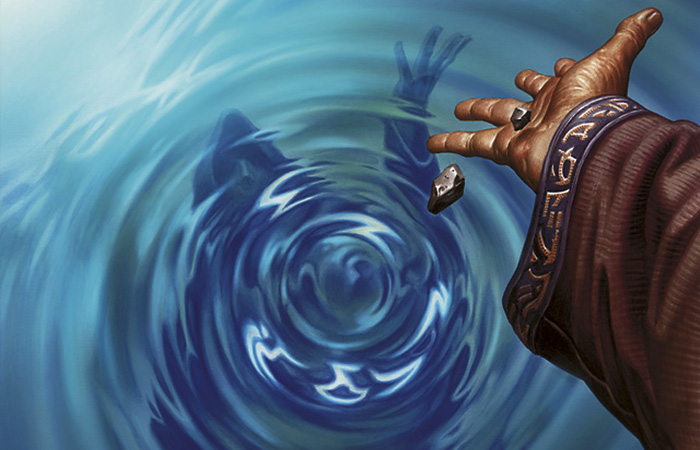
Cast Through Time | Art by Zoltan Boros & Gabor Szikszai
#5—It Saves Time
Before you start design, the possibilities are infinite. Infinite is pretty daunting. Each choice you make with the vision not only sets direction but it also removes large swaths of design. This is crucial early on because it can help you avoid giant time sinks.
#6—It Creates Comfort
People are happier when the leader has a plan. It gives them confidence that the time and energy they are going to spend will be useful and productive.
Now let's look at how it impacts the different components of design:
Card File
This is the point in the design where you create all the commons and usually most of the uncommons. The goal of this stage is to get to a point where you can start playtesting, first with all commons and eventually with uncommons mixed in. This is also the stage where you start to figure out what mechanics the set is going to have. Everything isn't finalized by the end of the stage, but usually you have half to all of the mechanics figured out. That doesn't mean they're in their finished state but you know the space you're playing around in.
Obviously, by the end of this stage, you need to have your vision—which means you know your theme, what mechanical space you're playing around in, and what the basic structure is going to be. In general, this means you exit this stage with a well-defined design skeleton. You haven't made all your rares and mythic rares yet (although odds are you've made some while trying to make commons and uncommons) but you have a good sense of the kinds of things you're going to need.
Playtesting
You can start playtesting as soon as you've filled in your commons. Remember that a lot of the early cards you create are more to test out themes and mechanics, which means that they will change drastically over time. Playtesting at this stage happens about once every two to three weeks with significant file adjustment between the playtests. This is the time for experimentation. Do not be afraid to try something crazy for one playtest to gather information. Playtests at this stage are almost exclusively Sealed.
Also, I recommend playtesting multiple times with the same card file at this point. The goal is to experience every card you can to sense what is working and what is not. Remember to prioritize playing different colors and themes from playtest to playtest. The goal isn't to win, it's to experience the set. Finally, I would suggest using what we call "the two rule" in early playtesting. Unless you are testing out a theme that needs duplicates, do not play with more than two copies of any one card, and when choosing between the second copy of a card and a card you've never played, opt for the latter.
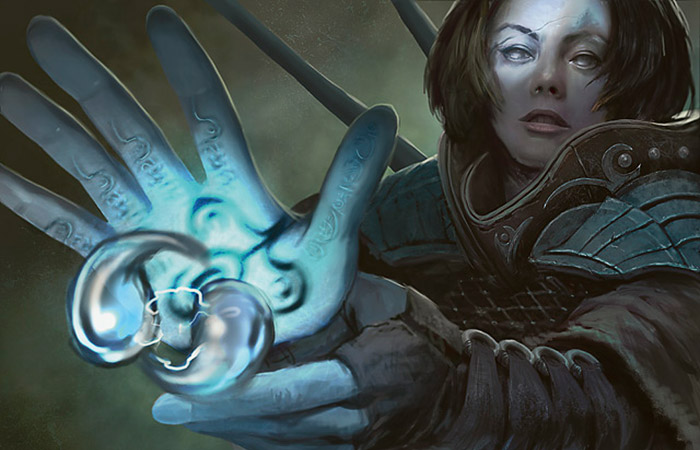
Think Twice | Art by Anthony Francisco
Iteration
In this first stage, you want longer iterations with large amounts of change happening between playtests. You learn a lot during these early playtest, so don't be afraid to make numerous changes to address all the things you've learned. My one warning is to not throw out the baby with the bathwater. What I mean by that is just because some cards of a mechanic or theme don't work does not necessarily mean the whole mechanic or theme needs to be thrown out. A lot of early iteration is about figuring out what aspect of a mechanic or theme is working so you can shift more cards into that design space.
Please remember that R&D keeps these stages to four months because we are on a deadline. We do not have the luxury of pushing things back. You do. Do not move on from the vision stage until you have your vision. If, at this point, you cannot articulate what your set is about and what its major themes and mechanical components are, you are not ready to move out of this stage. If you do not properly build your foundation your set can structurally collapse later, which will be infinitely harder to fix.
The Integration Stage
If the vision stage is about defining why, the integration stage is about defining how. The integration stage is where you start to see how things come together, both internal to the design and external to design, as you begin thinking about how the design will interact with other parts of R&D and the rest of Wizards. You leave the vision stage with many components. The integration stage is figuring out how those components are going to work together and what will need to be added or subtracted to make it work.
Integration does the following:
#1—It Puts Mechanics Through Their Paces
During the vision stage, you find mechanics to reinforce the set's themes. During the integration stage, you figure out what makes those mechanics tick. This middle stage is all about playing and refining.
#2—It Builds Relationships Between Components
When components are added during the vision stage, you are mostly making sure that they fit the vision. During the integration stage, you have to start thinking about how they interact with one another. The fact that they are unified by the vision usually means that there is some inherent synergy between them, but that is not always the case. Integration will either show you how to make them work together or instruct you that one or more of them needs to get pulled.
#3—It Supplements the Set
As you evolve the set, you will start to realize that there are gaps. Mechanics and themes will shift, often opening up holes in your structure that needs to be addressed. A lot of the material added in during integration will be to help supplement these areas.
#4—It Sheds Unneeded Elements
As you continue to play with the set, you will find some components are not serving the greater good and need to be cut. Oftentimes, these elements are good designs in a vacuum but fail to serve a larger function in the set. If a card does not advance the larger set around it, no matter how good a design it is, it needs to go. Magic is a hungry monster. There will also be plenty of room in the future for a well-designed card.
#5– It Stress Tests the Weak Spots
Integration is not just about finding what works in a set but also discovering where a set is most vulnerable. Sometimes, that means removing weak spots, but more often than not—as every set has weak spots—it means figuring out how to reinforce the set to function with them in the file.
#6—It Illuminates Problems Coming Down the Road
There are realities that will have to be faced before a set can make it to print. Part of integration is interfacing with other sections of the company so you can start addressing concerns while it's still easy to make changes. For example, it is during the integration stage that I usually get an initial pass on the rules for the new mechanics as well a rough version of the templating. Will this mechanic actually function the way I want it to? How wordy will the card text have to be? The answers to these questions can have a big impact on how the mechanic is made.
Let's examine how this stage affects design:
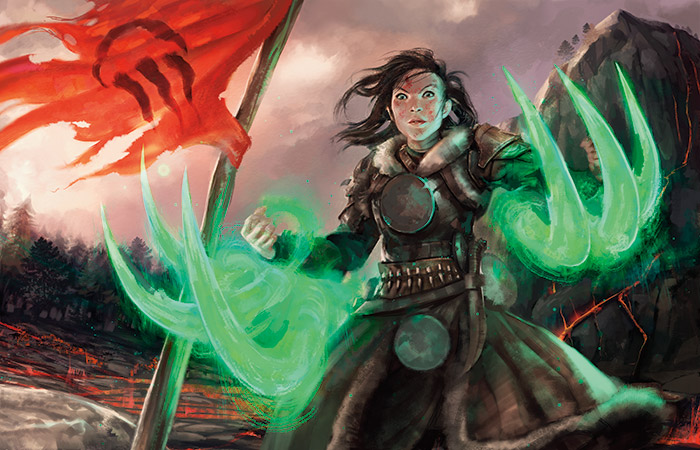
Temur Runemark | Art by Ryan Alexander Lee
Card File
This stage starts with all the commons and all or most of the uncommons. This stage ends with a completed card file. This doesn't mean every card will make it through the next stage intact, but the file is in a place where full playtests can occur. This stage is about fine-tuning, so the file will still be in constant flux. As the stage moves along, the changes should be more about tweaking cards than wholesale replacement.
At the end of this stage, you are presenting your first draft of the full file. Every card should be purposeful and represent a component you actively want in the set. It's fine to keep notes in your file if you know you have elements that still need to be improved. Ideally, all the mechanics are decided by the end of the integration stage.
Playtesting
During this stage, playtesting happens every one to two weeks and tends to rotate between Limited play and Constructed play. Constructed play usually does not begin until you have a significant number of the rares. Constructed play focuses on building decks within the set, centering on themes of the set. The reason that Constructed playtests are so important is that they show you gaps that don't matter during Limited play. One of the best ways to discover things that are missing in the file is building decks and realizing that you don't have some piece you need to make your deck work.
Limited playtests during this stage start as Sealed Deck but during the second half can start becoming Draft. You don't want to draft until your themes are cemented enough that players can draft around them. Draft playtests are very important because they will stress-test your themes and ensure that your Limited play has enough depth.
Iteration
During this stage, your changes between playtests will lessen. This doesn't mean you can't make big changes but that you will find fewer things that need major overhauls. Because the changes will be fewer, and because you have more formats to test, your playtests will become more frequent.
You want to end the vision stage with a vision. You want to end the integration stage with a set. It's not done yet, as you have a whole stage left, but it is the first draft of the thing you want to eventually print.
The Refinement Stage
You begin this last stage with your first draft of the full file and then are constantly reworking it for four months. Halfway through is when "devign" begins, which is where development starts meeting on the set and giving in-depth feedback for design to address. This stage is about a lot of smaller incremental changes that get the set ready for the handoff to development.
The main roles of refinement are:
#1—Find the Best Execution
Early design is about getting your set in the general space of where you want it to be. Refinement then moves the set to its optimal position. If early design is macro, with you thinking about big-picture issues, refinement is micro, with you looking at every decision with a magnifying glass searching for any room for improvement.
#2—Fix Problems
The metaphor I like to think of here is that of sculpting. When you begin, you have a giant stone slab and your job is to carve away everything that isn't supposed to be there. We are constantly messing around in virgin design space doing things that Magic hasn't done before. And even when we revisit old themes, we mix and match them with different themes than the last time we used them. This introduces a lot of chaos into the system and part of design's job (and later part of development's job) is carving away the chaos.
#3—Fine Tune the Creative Connections
The design team communicates with the creative team through all of design, but early on it is about more big-picture issues. By the time we get to refinement, it's time to start connecting specific creative elements—characters, places, plot elements. It is usually during this stage, for instance, that we make legendary creatures or Planeswalkers (which often are constantly fiddled with throughout development).
#4—Make Late Changes
A lot of design is about pushing the envelope and trying new things. There comes a point, though, where you have to take an honest look at a new element and make sure it actually can be done. When you hear stories about us trying something crazy that we finally had to let go, it's often during refinement that such a thing happens. Refinement is time to take a serious look at what the set is doing and make sure that realistically it can be done.
Here's how the stage affects design:
Card File
This stage starts with the first draft of the design file and ends with the last draft. It's during this time that we tend to clean up the file and make sure all our ducks are in order. In the last few years, design has started to keep some of the cards removed near the end of the design and mark them as 66s in the file. This way, if development needs to kill cards, there are some extras to choose from.
Playtesting
Playtesting happens every week during this stage. A design team traditionally meets twice a week, so once a week we playtest and then in a meeting we discuss the results of the playtest and make changes to the file. Lather. Rinse. Repeat. The changes that happen during this stage are much more minor, especially as we get to the end of the stage. This is where we might do smaller tweaks like changing a mana cost or power/toughness. It's important during this stage to get a lot of other people outside of your design team to playtest. Once development starts up during devign, they often join us for our weekly playtests. During this last stage we still do Constructed and Limited playtesting, with the Limited playtesting being mostly Draft.
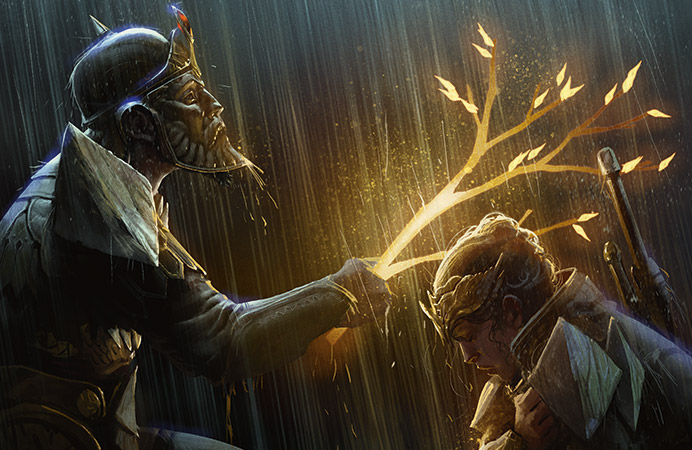
Honor’s Reward | Art by Izzy
Iteration
This final stage has the quickest iteration, as things are changing every week. It's very common during playtests to have someone taking notes and jotting down every time a problem card comes up. During this stage, we are much more concerned with how individual cards affect the environment as a whole, and changing one card often means having to change several.
And then just like that (okay, after a whole year), design ends and the file is handed off to development. As part of this process, the lead designer creates a "Design Philosophy" document to walk development through the vision and all the decisions that went into the design.
"Game, Set, Match"
I hope today's article gave you a little better sense of the larger scope of design and the different stages it moves through. As I mentioned above, please don't feel beholden to R&D's timetable. We have a lot more resources and experience as well as a very solid deadline to make sure we get things done on time.
As always, I am eager for any feedback, not just on this article but what topics you'd like to see in future "Nuts & Bolts" articles. You can send me an email or respond to me through any of my social media (Twitter, Tumblr, Google+, and Instagram).
Join me next where when there will be dragons.
Until then, may you have as much fun making your set as we have making ours.
"Drive to Work #212—Technology"
This podcast talks all about the technological tools design (and the rest of R&D) uses to do its job.
"Drive to Work #213—10 Things Every Game Needs #4—A Catch-Up Feature"
This is the fourth part in my 10-part series "10 Things Every Game Needs."
- Episode 213 10 Things Every Game Needs (14.0 MB)
- Episode 212 Technology (15.1 MB)
- Episode 211 Mistakes (16.8 MB)
- Episode 210 Back in the Day (15.0 MB)
- Episode 209 Iteration (18.9 MB)
- Complete Drive To Work Podcast Archive

